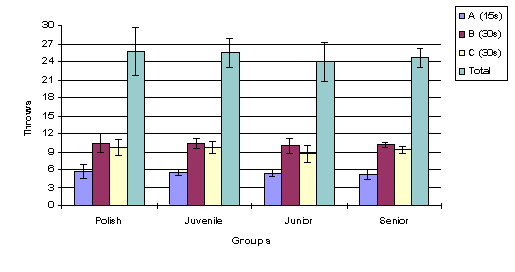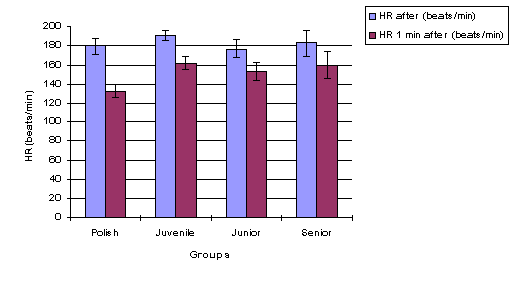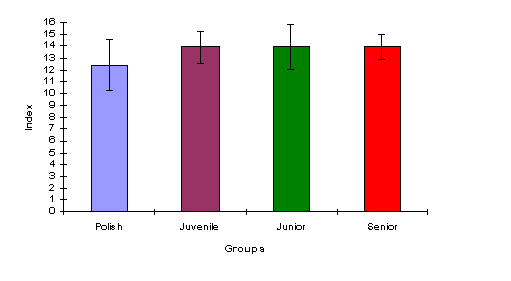– PhD, Professor of Department of Combat Sports, APE-KP.ABSTRACT
The present study objectified to verify if there was difference in the performance of a specific anaerobic lactic test of judo in athletes of different age groups (Juvenile, Junior and Senior) submitted to same training. The sample was constituted of 06 judoists of the Juvenile class, 05 judoists of the Junior class and 06 judoists of the Senior class, that agreed in participating of the research after informed consent. The test was accomplished as proposed by STERKOWICZ (1995) and the data were analyzed through an ANOVA one way followed by Tukey test when found significant difference. It was not found any difference among the groups in the performance of the test, indicating that athletes with superior age to 16 years submitted to the same training type tend to have similar performance in the test proposed by STERKOWICZ (1995).Those findings needs further research, yet.
1. INTRODUCTION
Judo is a sport that requests high level of physical and psychological preparation, technique and tactics (LITTLE, 1991). Some studies have been approaching these aspects (CALLISTER et al, 1991; CASTARLENAS & PLANAS, 1997; EBINE, YONEDA & HASE, 1991; HAN, 1996; THOMAS et al., 1989), but few works have been accomplished in the order of obtaining a specific test to evaluate judo athletes (NUNES, 1997). Combat sports as the wrestling already present specific tests for the athletes’s evaluation (KLINZING & KARPOWICZ, 1986; UTTER et al., 1997).
STERKOWICZ (1995) proposed a specific test to evaluate the judo athlete’s physical condition. This test, of intermittent character, has as great advantage the fact of using a specific movement of the modality (ippon-seoi-nage). However, no study objectified to verify differences in the index proposed by STERKOWICZ (1995) in athletes of different age groups.
2. OBJECTIVE
The objective of this work was to verify if there was a difference in the performance during the test proposed by STERKOWICZ (1995) in athletes submitted to the same training type but of different age groups (Juvenile, Junior and Senior).
3. METHODS
3.1. Sample
Seventeen (17) judoists (06 Juvenile; 05 Juniors and 06 Seniors) participated in this study after they sign term of informed consent.
3.2. The Special Judo Fitness Test
This test objectifies to verify the anaerobic lactic capacity of judo athletes with specific movements of the modality. The test was accomplished as described by STERKOWICZ (1995): Two judoists (uke) of similar stature and body mass of the performer (same category) are positioned at 6m of distance one of the other, while the performer of the test (tori) it is to three meters of distance of the judoists that will be throw. To the command of “go”, the performer runs in direction of one of the uke and he accomplishes the Ippon-seoi-nage technique throwing the uke and soon after he runs to the other uke and he accomplishes the same movement and so on during 15s. At the 15s the assessor commands “stop”, starting from which the performer has 10s of interval to begin the next series with identical procedure to the first even so with duration of 30s. At the end of the period of 30s, the performer has more 10s of interval and he accomplishes another period of 30s. Heart rate is registered at the end of the test and 1 minute after its end. The total of accomplished throws is added and the index below is calculated:
Index = HR after (beats/min) + HR 1min after the end of the test (beats/min) / total number of throws
Therefore as smaller the better index the performance in the test.
Outline of the test:
| 3m | 3m |
| Uke A | —————– | Tori | —————– | Uke B |
| ___________ | 6m | ___________ |
The heart rate was obtained through the use of the POLAR Night Vision.
After the test the athletes were questioned with relationship to the likeness of the fatigue that they felt on that moment with what they felt already after a fight of 4 minutes in competition and after a training of judo of 1 hour and 30 min. It was presented to the athlete a record it conforms below:
- 1 = little likeness
- 2 = little more likeness
- 3 = moderate likeness
- 4 = very likeness
- 5 = a lot of likeness
3.3. Statistical Analysis
It was used the statistical package Statistica for Windows version 4.2 Statsoft Inc. 1993 to the parametric analysis ANOVA one way proceeded by Tukey test. The level of significance adopted was p < 0,05.
4. RESULTS
The age group and body mass of the athletes can be observed in Table 01:
| Juvenile (n = 6) | Junior (n = 5) | Senior (n = 6) |
| Age (years) | 16,5 ± 0,55 * | 19,3 ± 1,20 * | 23,5 ± 2,17 * |
| Body mass (kg) | 64,2 ± 7,62 | 70,9 ± 7,94 | 73,6 ± 9,66 |
* p <0,02. Mean ± Standard deviation
Table 01: Age (years) and body mass (kg) of the juvenile, junior and senior groups.
The results of the performance in the test for each one of the groups can be seen below in the table:
| Juvenile (n = 6) | Junior (n = 5) | Senior (n = 6) |
| A – 15s (number of throws) | 5,50 ± 0,55 | 5,40 ± 0,55 | 5,17 ± 0,75 |
| B – 30s (number of throws) | 10,33 ± 0,82 | 10,0 ± 1,22 | 10,17 ± 0,41 |
| C – 30s (number of throws) | 9,67 ± 1,03 | 8,60 ± 1,52 | 9,33 ± 0,52 |
| Total of throws | 25,50 ± 2,40 | 24,00 ± 3,29 | 24,67 ± 1,68 |
| HR after (beats/min) | 190,8 ± 5,34 | 177,0 ± 9,25 | 182,7 ± 13,34 |
| HR 1min after (beats/min) | 162,2 ± 7,05 | 153,6 ± 9,89 | 160,3 ± 14,16 |
| Index | 13,94 ± 1,33 | 13,95 ± 1,86 | 13,92 ± 1,04 |
Mean ± Standard deviation
Table 02: Performance in the test of STERKOWICZ (1995) for judoists of different classes.
The Table 03 presents the perception of the likeness of the fatigue after the test and the fatigue after a fight of 4 minutes, and the perception of the fatigue after the test and the fatigue after a training of 1 hour and 30min.
| Test and Fight | Test and Training |
| little likeness | 0 | 0 |
| little more likeness | 0 | 12 |
| moderate likeness | 18 | 41 |
| very likeness | 41 | 35 |
| a lot of likeness | 41 | 12 |
Table 03: Distribution (%) of the perception of the likeness among the fatigue after the test and the fatigue after a fight of 4 minutes and distribution (%) of the perception of the likeness among the fatigue after the test and the fatigue after a training of 1 hour and 30 minutes.
5. DISCUSSION AND CONCLUSION
Starting from the statistical analysis it was verified that the groups didn’t differ to each other with relationship to the body mass, but just with relationship to the age, indicating that the performance in the test didn’t suffer influence of the body mass. Any type of difference was not verified in any of the variables of the test (throws in the phase A – 15s, throws in the phase B – 30s, throws in the phase C – 30s, total of throws, heart rate in the end of the test, heart rate after one minute and index). This way, it can be noticed that athletes with superior age to 16 years of age submitted to the same training type tend to have similar performance in the test proposed by STERKOWICZ (1995).
When comparing the index of the judoists of this study with the index of the Polish judoists investigated by STERKOWICZ (1995), it was verified that the one of this study presented inferior results. This fact is due to the values of the heart rate 1 minute after the test were very high for these athletes, and for the juvenile athletes that difference in the index also have been cause by the largest heart rate after the test, while for the juniors and seniors athletes the smallest number of entrances in elapsing of the test also contributes to an inferior index. For better understanding see the graphs to proceed:
Figure 01: Number of throws in each one of the periods for Polish judoists of the study of STERKOWICZ (1995) and for the one of this study.

Figure 02: Heart rate immediately after and 1 minute after the test for Polish judoists investigated by STERKOWICZ (1995) and for the one of this study.

Figure 03: Final index for judoists investigated by STERKOWICZ (1995) and the one of this study.

These data must be interpreted with caution, because SIKORSKI et al. (1987) found that during the judo contests sequences of work are usually not longer that 30s and breaks are three times shorter and competitors of light weights categories attack more often than judoists of heavier categories. The techniques most often applied in competitions of the highest range were Seoi nage. In addition we would like to quote another work results (STERKOWICZ 1996) in which the same twenty Polish seniors participated. Measurements for special test were taken four days before Polish Championship. After the tournament judoists were divided by two levels of competition achievements. The group of higher achievements H (n = 10) showed statistically significant differences (p < 0.05) in comparison to lower achievements group L (n = 10) in number of throws: sets B were 11±1,82 – 9,8±0,91 and C = 10,3±1,64 – 9,0±0,67 and Total of throws = 27,4±4,76 – 24,0±2,0). HR after test was 177,0±9,49 – 181,8±6,36 beats/min, HR after 1 min rest was 129,6±7,04 – 135,6±4,19 beats/min, and as a consequence lower, i.e. better index 11,57±2,52 – 13,28±1,34. So, in practice of interval training group H can start after 1 min rest, whereas group L have to wait, yet. From practical point of view it was interesting relationship between index of 20 competitors and their rank at All Polish Individual Championship tournament results, too (Spearman rank correlation was 0,64 (p < 0,01)).
Another important aspect to be considered on this test is that 41% of the Brazilian athletes considered the fatigue after the test very similar and 41% a lot of similar to the fatigue after a fight of 4 minutes. With relationship to the likeness among the fatigue after the test and the fatigue after a training of 1 hour and 30 minutes, 41% of the athletes considered of medium likeness and 35% considered very similar. These data are coherent if it be considered that, in general, the intensity of the trainings is inferior to the intensity of the fight, in way to allow a training for superior time at one hour.
From research of SIKORSKI et. al. (1987) we know that the post-effort lactic acid (LA) concentration of the Polish judoists participating in national and international tournaments was 13,6±2,6 mmol/l (an average from 51 first fights). BRACHT et al. (1982) found that the blood lactate response to three fights, in brazilian judo players, were 7,50±2,51, 8,31±2,46 and 7,68±2,56 mmol/l, respectively. FRANCHINI et al. (1996) found no differences in peak blood lactate responses in juvenile, junior and senior brazilian judo athletes after three matches (see Table 04).
Table 04: Peak blood lactate (mmol/l) in juvenile, junior and senior brazilian judo players after three fights (from FRANCHINI et al., 1996).
| Juvenile (n = 7) | Junior (n = 5) | Senior (n = 3) |
| Fight 1 | 10,24±2,52 | 10,68±1,19 | 11,77±3,93 |
| Fight 2 | 10,95±3,27 | 10,48±1,32 | 11,23±2,17 |
| Fight 3 | 9,23±1,70 | 9,80±2,62 | 11,20±4,50 |
The studies of CALLISTER et al. (1990 and 1991) about blood lactate responses to randori found values of 8,9±0,5 and 9,1±1,1 mmol/l in elite american judo athletes. Table 05 presents the results of a research of FRANCHINI et al. (unpublished data) about the post special judo fitness test blood lactate concentration:
Table 05: Blood lactate concentration (mmol/l) in brazilian juvenile (16 and 17 years old) and adults (over 18 years old) judo players before and after the special judo fitness test (From FRANCHINI et al., unpublished data).
| Blood Lactate (mmol/l) | Juvenile (n = 6) | Adults (n = 6) |
| Before | 1,65 ± 0,87 | 1,50 ± 0,46 |
| 1 min after the test | 7,12 ± 2,81 | 10,01 ± 2,71 |
| 3 min after the test | 8,05 ± 3,71 | 9,82 ± 2,19 |
| peak | 8,20 ± 3,53 | 10,67 ± 2,33 |
mean ± standard deviation
Theses data show high likeness between the special judo fitness test and the judo match and between the special judo fitness test and randori, when considering blood lactate responses.
Many other studies can be accomplished with this test, for example: to verify if athletes accomplishing body mass reduction presents modification in the performance of the test.
6. BIBLIOGRAPHICAL REFERENCES
BRACHT, V.; MOREIRA, N.; UMEDA, O. Y. Efeito de lutas sucessivas sobre o nível de ácido láctico sangüíneo de judocas. Revista de Educação Física, Londrina, v. 03, n. 06, p. 25-28, julho de 1982. (BRACHT, V.; MOREIRA, N.; UMEDA, O. Y. Effect of sucessive fights on lactic acid level in judo players. Journal of Physical Education, Londrina, v. 03, n. 06, p. 25-28, july, 1982.) – in portuguese.
CALLISTER, R.; CALLISTER, R. J.; FLECK, S. J.; DUDLEY, G. A. Physiological and performance responses to overtraining in elite judo athletes. Medicine and Science in Sports and Exercise, v. 22, n. 6, p. 816-824, 1990.
CALLISTER, R.; CALLISTER, R. J.; STARON, R. S. ; FLECK, S. J.; TESCH, P.; DUDLEY, G. A. Physiological characteristics of elite Judo athletes. International Journal of Sports Medicine, v. 12, p. 196-203, 1991.
CASTARLENAS, J. L. & PLANAS, A. Study of temporal structure of judo combat. Apunts – Physical Education and Sports, n. 47, p. 32-39, 1997. (CASTARLENAS, J. L. & PLANAS, A. Estudio de la estructura temporal del combate de judo. Apunts – Educación Física y Deportes, n. 47, p. 32-39, 1997.) in Spanish.
EBINE, K.; YONEDA, I.; HASE, H. Physiological characteristics of exercise and findings of laboratory tests in Japanese elite judo athletes. Médecine du Sport, v. 65, n. 02, 1991.
FRANCHINI, E; TAKITO, M. Y.; LIMA, J. R .P.; HADDAD, S.; KISS, M. A. P. D. M. Blood lactate concentration in juvenile, junior and senior judo players – from laboratorial tests and fight. In: III CICEEF e I SPGEEF, São Paulo, 1996. Annals. School of Physical Education of University of São Paulo, São Paulo, 1996. p. 91.(FRANCHINI, E; TAKITO, M. Y.; LIMA, J. R .P.; HADDAD, S.; KISS, M. A. P. D. M. Concentração de lactato sangüíneo em judocas das classes Juvenil-A, Júnior e Sênior – a partir de testes laboratoriais e em situação de luta. In: III CICEEF e I SPGEEF, São Paulo, 1996. Anais. Escola de Educação Física da Universidade de São Paulo, São Paulo, 1996. p. 91.) – in porutguese.
FRANCHINI, E.; NAKAMURA, F. Y.; TAKITO, M. Y.; KISS, M. A. P. D. M. Wingate and the special judo fitness test blood lactate responses in brazilian juvenile and adults judo players. (unpublished data). (FRANCHINI, E.; NAKAMURA, F. Y.; TAKITO, M. Y.; KISS, M. A. P. D. M. Resposta da concentração de lactato sangüíneo em atletas brasileiros de judô juvenis e adultos. – dados não publicados).
HAN, M. W. Psychological profiles of Korean elite judoists. The American Journal of Sports Medicine, v. 24, n. 06, p. S67-S71, 1996.
KLINZING, J. E.; KARPOWICZ, W. The effects of rapid weight loss and rehydration on a wrestling performance test. Journal of Sports Medicine, v. 26, p. 149-156, 1986.
LITTLE, N. G. Physical performance attributes of Junior and Senior women, Juvenile, Junior and Senior men judokas. Journal of Sports Medicine and Physical Fitness, v. 31, p. 510-520, 1991.
NUNES, A. V. The difficult of evaluation in high level judo athletes. Proceedings of International Symposium of Science and Technology in Sport. Porto Alegre (RS): November 19-22, 1997, article 39-40. (NUNES, A. V. As dificuldades de avaliação de atletas de judô de elite. Proceedings do Simpósio Internacional de Ciência e Tecnologia no Esporte. Porto Alegre (RS): 19-22 de novembro de 1997, artigo 39-40.) in portuguese.
STERKOWICZ, S. Test specjalnej sprawnosci ruchowej w judo. Antropomotoryka, n. 12-13, p. 29-44, 1995.in Polish.
SIKORSKI, W., MICKIEWICZ, G., MAJLE, B., LAKSA, C. Structure of the contest and work capacity of the judoists. International Congress on Judo Contemporary Problems of Training and Judo Contest”. 9-11 November, 1987, Spala-Poland, p. 58-65 (a paper).
STERKOWICZ, S. W poszukiwaniu nowego testu specjalnej sprawnosci ruchowej w judo. Trening, n. 3, p. 46-60. In Polish.
THOMAS, S. G.; COX, M. H.; LEGAL, Y. M.; VERDE, T. J.; SMITH, H. K. Physiological profiles of the Canadian National Judo Team. Canadian Journal of Sport Sciences, vol. 14, n. 3, p. 142-147, 1989.
UTTER, A; GOSS, F.; DASILVA, S.; KANG, J.; SUMINSKI, R.; BORAS, P.; ROBERTSON, R.; METZ, K. Development of a wrestling-specific performance test. Journal of Strength and Conditioning Research, v. 11, n. 2, p. 88-91, 1997.
Acknowledgments: The authors wish to thank the coaches Douglas Vieira, Luciano Matheus, Carlos Rebelo, Solange Pessoa and Walmir Barbosa da Silva and to the athletes for their collaboration which made this study possible.




